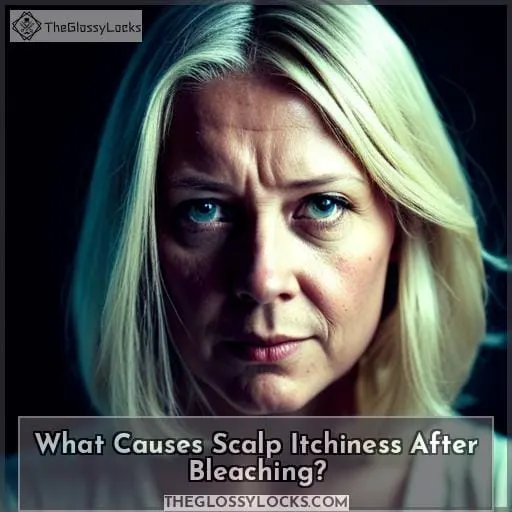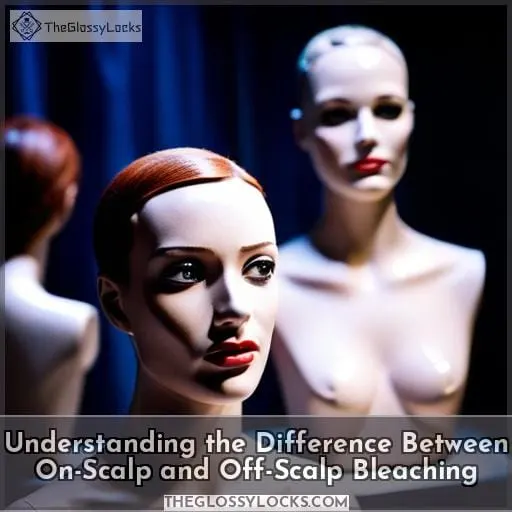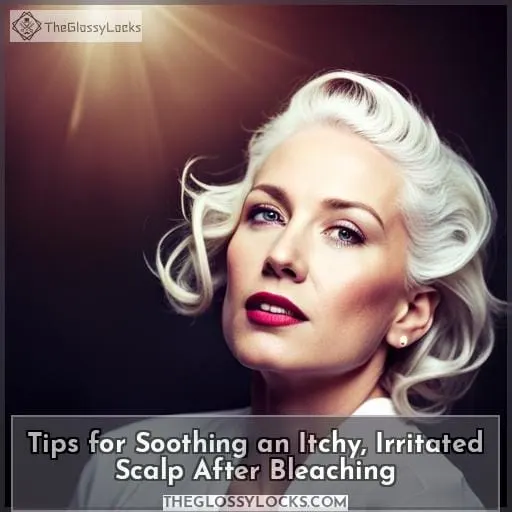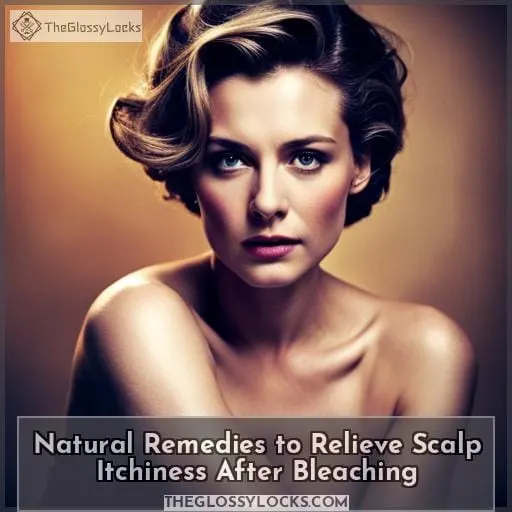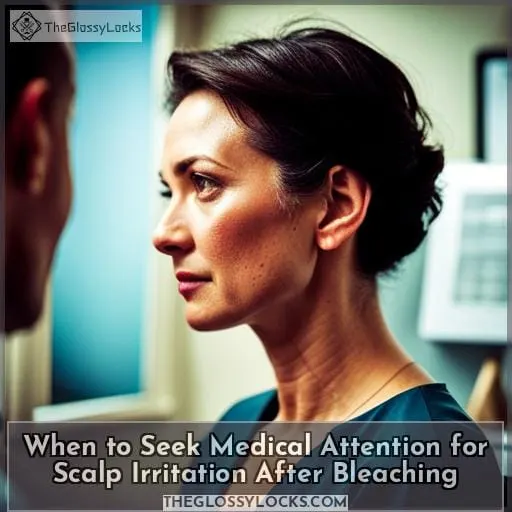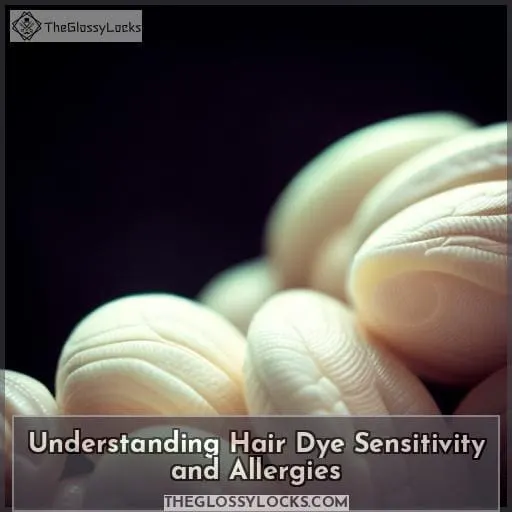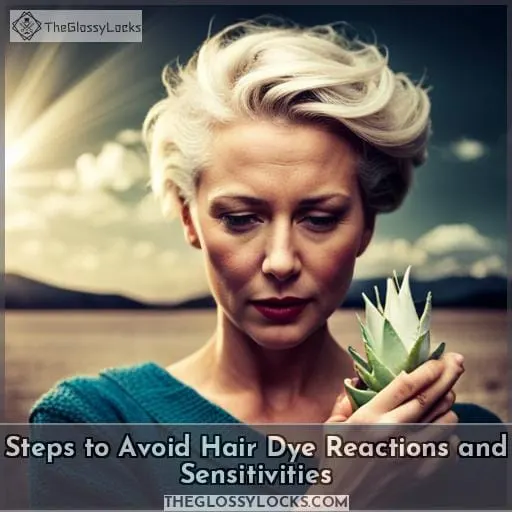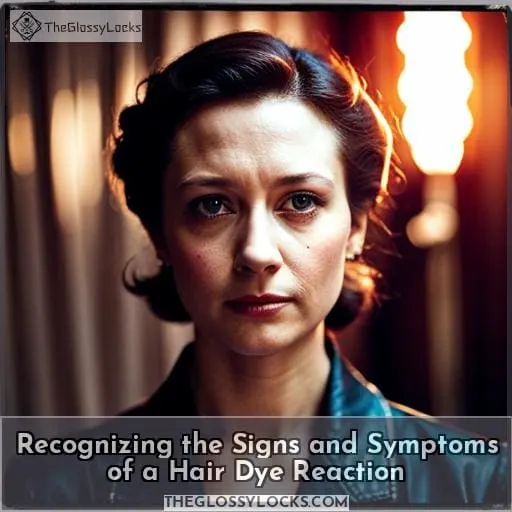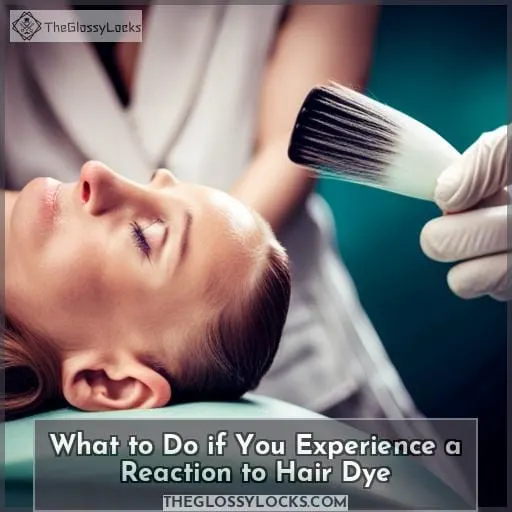This site is supported by our readers. We may earn a commission, at no cost to you, if you purchase through links.
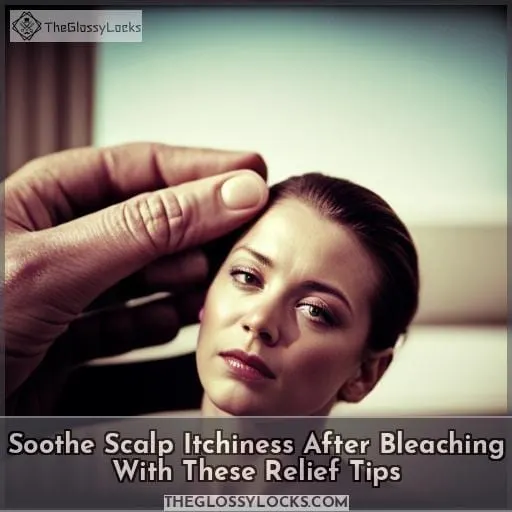
First, rinse with cool water. This can provide soothing relief to your scalp. Also try applying natural remedies like lemon juice.
With some gentle care, you’ll be back to happily rocking your fresh, lightened locks in no time. The desire to change our hair color often leads us to bleach. But we understand it can leave your scalp irritated or itchy afterwards.
You just want to feel more vibrant. The tips here will help soothe that scalp itchiness, so you can get on with feeling great in your new ‘do.
Table Of Contents
- Key Takeaways
- What Causes Scalp Itchiness After Bleaching?
- Understanding the Difference Between On-Scalp and Off-Scalp Bleaching
- Tips for Soothing an Itchy, Irritated Scalp After Bleaching
- Natural Remedies to Relieve Scalp Itchiness After Bleaching
- When to Seek Medical Attention for Scalp Irritation After Bleaching
- How to Prevent Scalp Itchiness After Bleaching in the Future
- Understanding Hair Dye Sensitivity and Allergies
- Steps to Avoid Hair Dye Reactions and Sensitivities
- Recognizing the Signs and Symptoms of a Hair Dye Reaction
- What to Do if You Experience a Reaction to Hair Dye
- Conclusion
Key Takeaways
- Cool water rinses can provide quick relief from scalp itchiness and inflammation.
- Moisturizing the scalp with aloe vera gel or oils is essential for hydrating dry, irritated skin.
- Avoid scratching the scalp, as this can exacerbate irritation.
- Use a gentle, fragrance-free shampoo designed for sensitive skin.
What Causes Scalp Itchiness After Bleaching?
You’re likely itching ’cause those harsh chemicals stripped your scalp! That scalp itchiness after bleaching can be caused by chemical burns, scalp sensitivity, or an allergic reaction to ingredients like hydrogen peroxide or paraphenylenediamine (PPD).
The bleaching process strips your scalp and hair of natural oils, leaving it dry, irritated, and inflamed. But there are some simple, natural remedies that may provide cooling relief like aloe vera gel, apple cider vinegar rinses, and coconut oil.
To prevent itching after future bleaching, do allergy testing beforehand and opt for gentler, PPD-free formulas. And see a doc for severe irritation or discomfort that lasts more than a few days.
Understanding the Difference Between On-Scalp and Off-Scalp Bleaching
Having hair bleached right on your scalp means closer chemical contact, increasing irritation risks. Off-scalp bleaching keeps chemicals away from your scalp by using foils or mesh caps.
- On-scalp bleaching directly contacts the scalp.
- Off-scalp bleaching uses barriers between chemicals and scalp.
- On-scalp bleach raises irritation and burn risks.
- Off-scalp bleaching is gentler on the scalp.
When deciding between DIY and salon bleaching, consider risks. Doing it yourself means handling harsh chemicals yourself. Seek out experienced, reputable stylists for safest results. They can recommend gentle, quality products and techniques to reduce scalp irritation after bleaching.
Scalp itchiness after bleaching can arise for several reasons. The harsh chemicals in bleach, like peroxide, can irritate and inflame the scalp. Bleach removes melanin and lipids that protect hair and skin, causing dryness that makes you itch.
An allergic reaction or contact dermatitis from ingredients like paraphenylenediamine is another common culprit. The itchiness usually starts 1-2 days after bleaching and can last weeks. Itching is the scalp’s way of communicating damage or an irritant reaction.
To soothe it, gently cleanse and moisturize the scalp while avoiding scratching. See a doctor if severe itching, redness, swelling, oozing or crusting occurs, as these may indicate a chemical burn or infection requiring medical treatment.
With proper aftercare, itchiness should resolve over time as the scalp recovers.
Tips for Soothing an Itchy, Irritated Scalp After Bleaching
There are straightforward ways to soothe an irritated, itchy scalp after bleaching. Rinsing your scalp with cool water can give quick relief from irritation by taking away any leftover chemicals and calming inflammation.
You can also try applying a gentle, moisturizing shampoo made for color-treated hair. Massage it gently into your scalp. Let it sit for a few minutes before rinsing to allow the nourishing ingredients to soak in.
Apple cider vinegar mixed with water is another option. Pour it over your hair after shampooing. The acetic acid in the vinegar will help restore your scalp’s pH balance. Leave the mixture on for 5-10 minutes before rinsing.
Finally, use an intensive deep conditioning hair mask. Look for ones with soothing ingredients like aloe vera or coconut oil. Apply it liberally to your scalp and hair. Put on a shower cap and let the mask penetrate for at least 20 minutes before washing it out.
Rinsing With Cool Water
Feel the sweet relief as you drench your affected dome in refreshing, frigid water after bleaching. The cool water quickly soothes inflammation and reduces burning sensations on the scalp. It temporarily numbs irritated nerve endings to provide fast itch relief. The temperature change calms inflamed skin and closes pores to protect from further damage.
Rinsing thoroughly removes irritating residue to aid healing. Cool water offers immediate, drug-free relief to ease a troubled scalp after hair lightening procedures.
Use lukewarm water.
Pat dry with a towel.
Apply aloe vera gel.
Rinse with cool water for 3-5 minutes.
Avoid scratching.
Use a humidifier.
Repeat after 6 hours if needed.
Keep hair/scalp moisturized.
Take antihistamines.
Rinsing the scalp with cool water can provide soothing relief from itchiness and irritation after bleaching hair at home or in the salon. The cold temperature helps numb nerve endings, reduces inflammation, and flushes away hair dye chemicals that may be causing discomfort.
For best results, rinse for several minutes and repeat as needed. Combine with other methods like moisturizing and anti-itch creams.
Avoiding Scratching
Keeping your hands busy helps avoid scratching an irritated scalp after bleaching. Try fidget toys, stress balls, puzzles – anything that occupies your fingers. Moisturizing scalp masks also provide cooling relief.
See your doctor if you notice a rash, pain, weeping or swelling for proper diagnosis and treatment of potential chemical burns or dermatitis. They can provide steroid creams, antihistamines or other relief while advising on precautions for future hair coloring.
Using a Cool Compress
Wrap a cool compress around your head to calm the inflammation on your scalp after it’s been bleached. The chilled temperature will provide instant relief to your irritated, itchy scalp. Keep a soft towel between your skin and the compress to prevent discomfort. Re-cool and reapply the compress as needed for continued soothing.
Focus on the cold sensation numbing and calming the heat and sensitivity. With patience, the cooling comfort will start to override the irritation and itchiness. The compress helps relieve irritation by lowering skin temperature. Alternate with a towel to avoid discomfort from prolonged cold.
Reapply as needed for continued relief. The chilling effect soothes inflammation and itching.
Moisturizing the Scalp
Massage a small amount of aloe vera gel into the scalp after shampooing to moisturize and calm irritation.
- Coconut oil provides nourishment for the scalp.
- Applying jojoba oil softens the scalp and hydrates it.
- Shea butter can help seal in moisture on the scalp.
- Using argan oil on the scalp relieves dryness.
- Olive oil soothes an itchy scalp and calms irritation when applied.
Condition your hair regularly and avoid over-washing to maintain a healthy, hydrated scalp.
Using Mild Shampoo
You feel relief by using shampoo free of fragrances and other irritants that could worsen tender, bleached skin. Statistically, 1 in 3 hair color users report scalp irritation. Opt for a gentle, hydrating shampoo and conditioner formulated for sensitive skin.
Avoid products with added perfumes or chemicals that may aggravate the scalp after bleaching. Consider an oatmeal or tea tree oil shampoo to help treat itchiness and flakes caused by irritation.
Consider Over-the-Counter Medications
For itchy, irritated scalps after bleaching, consider taking over-the-counter medications to help reduce skin inflammation and itching. Antihistamines like Claritin, Zyrtec, or Benadryl can help block histamine and reduce itching.
Ibuprofen or acetaminophen provides relief from scalp discomfort. If symptoms persist beyond a few days or worsen, consult your doctor about prescription strength topical steroid creams or oral steroids to calm severe reactions.
Avoid scratching, as this can worsen scalp irritation. Stay hydrated and try applying a cool compress for temporary soothing relief while medications take effect.
Natural Remedies to Relieve Scalp Itchiness After Bleaching
You may experience scalp itchiness after bleaching due to irritation. Applying lemon juice can help soothe the itch by restoring your scalp’s pH balance and reducing inflammation.
Lemon Juice
Squeeze some lemon juice into your hair after shampooing to help relieve that itchy scalp.
- Naturally astringent
- High in vitamin C
- Acidity balances scalp pH
- Contains antioxidants
- Boosts shine
Lemon juice’s natural acidity and vitamin C make it an ideal remedy for soothing an itchy, irritated scalp after bleaching. Simply massage a few tablespoons into clean, damp hair and let it sit before rinsing.
The citric acid will help balance your scalp’s pH, reducing inflammation, while the vitamin C acts as an antioxidant, protecting hair.
Apple Cider Vinegar
After lightening that scalp, soak some apple cider vinegar into a cotton ball and dab it gently over the itchy spots for relief. The vinegar will bring your scalp pH back to normal, soothing irritation from the bleach.
An ACV rinse is a DIY haircare staple, restoring shine and keeping the scalp balanced. For best results, dilute it with equal parts water and massage into hair and scalp after shampooing.
Chamomile Tea
You see, over half of scalp irritation sufferers find relief rinsing hair with cooled chamomile tea.
- Chamomile tea soothes inflammation and redness.
- It has anti-irritant properties.
- Chamomile tea helps moisturize dry, damaged scalp.
- It can reduce scaling and flaking.
- The tea provides antioxidant protection.
Chamomile tea rinses can provide welcome relief when scalp itchiness flares up after at-home bleaching or excessive lightening. The natural oils in the tea calm irritation and help heal raw, sensitive skin. Consider giving chamomile tea a try next time ammonia or peroxide leaves your head frying.
Honey
Honey’s sweetness can help distract and delight your senses, friend. After experiencing hair bleaching damage, drizzle some honey over your poor scalp. Honey’s antiviral and anti-inflammatory qualities will begin healing the damaged skin.
Let the honey work its magic for an hour, then rinse it out. Honey’s antioxidants help reduce inflammation while its emollients hydrate the skin. Repeat this soothing honey mask weekly until the itch subsides. Opt for raw, local honey for maximum relief if possible.
Cinnamon
Cinnamon’s spicy properties can help calm post-bleach itching.
- Mix cinnamon powder into coconut or olive oil.
- Create an apple cider vinegar rinse with cinnamon.
- Add cinnamon to your regular conditioner.
- Blend cinnamon essential oil into a carrier oil.
For some people, cinnamon’s warming traits may relieve scalp irritation after bleaching.
When to Seek Medical Attention for Scalp Irritation After Bleaching
Though rinsing with water and using cool compresses provide home relief for minor scalp irritation, heading to urgent care for weeping blisters or spreading redness gives you peace of mind that a doc’s checking for chemical burns.
If your scalp feels raw, inflamed, or the pain persists for over a day, don’t wait. Seek a dermatologist right away, as chemical burns can rapidly worsen without proper care.
Off scalp bleaching lessens risk, but irritation still happens. Listen to your body – if OTC remedies and natural soothing methods like aloe vera or chamomile compresses haven’t calmed the itching and stinging within 24 hours, call your doctor.
They’ll assess if prescription meds are needed to reduce inflammation and prevent scarring.
How to Prevent Scalp Itchiness After Bleaching in the Future
Do a patch and allergy test before each bleaching session. Space out bleaching sessions by at least 4-6 weeks. Alternate bleaching with deep conditioning treatments. Use gentle, sulfate-free shampoos and conditioners.
Keeping up with scalp health between sessions is crucial. Avoid over-bleaching and give your hair adequate time to recover. Listening to what your scalp needs will help prevent irritation and itchiness down the line.
Understanding Hair Dye Sensitivity and Allergies
Many people experience itchy scalps after hair coloring due to sensitivities. The most common irritant is paraphenylenediamine (PPD) found in darker dyes. Reactions range from mild itching to severe allergic responses. To identify your sensitivities, allergy testing and skin patch-testing can check for PPD and other dye ingredients.
If you have reactions, avoid PPD-containing dyes. Seek emergency care for severe allergic symptoms like throat swelling or difficulty breathing. For milder symptoms, wash out the dye and use moisturizers. Antihistamines and steroid creams can provide relief too.
Being aware of sensitivities allows smart precautions. Perform patch tests each time and review safety instructions to prevent discomfort. PPD-free alternatives are available if you find certain dyes repeatedly cause scalp itchiness.
Steps to Avoid Hair Dye Reactions and Sensitivities
You can take important steps to prevent sensitive reactions to your next hair coloring. Seeing an allergist, carefully patch testing formulas, and using dye alternatives are excellent precautions against developing irritation or rashes from the process.
Performing a Patch Test
Break records by testing every product on your head first before buying to avoid color catastrophes!
- Apply a dime-size amount behind your ear for 48 hours.
- Examine for redness, itching, swelling, or blistering.
- Note which products cause discomfort.
- Avoid products that elicit adverse reactions.
Patch testing protects your scalp and ensures hair dye success.
Consulting an Allergy Clinic
Stop by an allergy clinic to pinpoint specific dye ingredients you are sensitive to. During a patch testing appointment, they will apply small amounts of common irritants, like PPD, to your skin. Look for redness or itching over the next 48 hours. This identifies problematic ingredients to avoid.
Anaphylactic reactions require immediate care, so review clinic preparation. Seek allergy-friendly methods like henna or plant-based dyes if you have severe sensitivities.
Taking Other Precautions
Take antihistamines ahead of coloring as a precaution. Remember to monitor your hair and scalp for signs of irritation after bleaching or coloring. A cool compress provides relief, but seek medical attention for severe reactions like swelling or rash.
Using homemade remedies and gentle shampoos can aid post-bleach care and prevent further irritation. With some simple steps, you can color safely and manage any discomfort that arises.
Recognizing the Signs and Symptoms of a Hair Dye Reaction
You’re noticing some signs of sensitivity after coloring your hair. Mild scalp irritation involves redness and itching, while allergic reactions can involve more severe symptoms like swelling, rash, or difficulty breathing.
Mild Scalp Irritation
Dry those tears because you can handle this. A mild reaction like scalp itching or redness indicates irritation, not danger. Rinse hair thoroughly and resist scratching. Test natural remedies like aloe vera gel, coconut oil, or hydrocortisone cream for relief.
Note precautions moving forward and consult a physician if symptoms continue or intensify.
Allergic Reactions
Cause sniffles and welts spell trouble, lover. Allergic reactions to hair dye range from mild to severe. Itching, burning, and swollen skin signal sensitivity. Hives, wheezing, and trouble breathing indicate anaphylaxis – seek help immediately! Always patch test new colors.
Review ingredients for common irritants like PPD. Discuss options with your stylist if you have sensitivities. There are allergy-friendly alternatives for coloring hair without a reaction. Prioritize health and safely dye those luscious locks.
What to Do if You Experience a Reaction to Hair Dye
Experiencing a reaction to hair dye can be frightening. For mild itching and discomfort, there are several at-home remedies to try.
Relieving Mild Symptoms at Home
Dab some hydrocortisone cream on irritated patches for fast itch relief. Soothe inflammation with a cool compress of green tea bags pressed against the scalp. Mix aloe vera gel and coconut oil to gently massage into itchy areas and moisturize.
Make a paste of apple cider vinegar, honey, and olive oil to naturally balance pH and calm irritation. For extra moisture, work in avocado or egg mixed with vitamin E oil. These home remedies bring natural itchy relief if you experience reactions from hair dye.
Seeking Medical Treatment for Severe Reactions
Head to the ER asap if you break out in hives or can’t breathe after coloring your hair. Severe reactions require immediate attention to prevent dangerous complications. Tell the doctor your symptoms and which hair products you used. They can provide medications like steroids to reduce inflammation and antihistamines to relieve itching.
With prompt care, even severe dye reactions can be managed safely. Don’t risk your health – seek help if symptoms seem extreme.
Avoiding Products Containing PPD
If nuts hide in that hair dye, bail on that allergy-causing brand sooner than Aunt Edna ditches a bad casserole! Steer clear of products with PPD by opting for gentler henna or plant-based dyes. Do that patch test and quiz your stylist on ingredients to pick a formula without irksome chemicals.
For sensitive skin prone to redness or itching, natural remedies like aloe, oatmeal baths, and moisturizing oils can soothe and protect your scalp. With knowledge and care, you can rock your vibrant locks minus the nasty reactions.
Conclusion
If you find yourself experiencing an itchy scalp after bleaching, don’t panic. There are natural remedies and relief tips that can soothe the irritation. Rinse your scalp with cool water and even try applying some fresh lemon juice. However, if the itching is severe or persists, be sure to see your doctor, as you may need medical treatment for chemical irritation or allergy.
With some care and relief tricks, you can help calm and soothe scalp itchiness after bleaching.

